A Step-by-Step Guide to Filling Out the W-2 Form

Table of Contents
How Do You Fill Out a W-2 Form Correctly?
A W-2 form reports an employee’s annual wages and the taxes withheld from their paycheck. First and foremost, employers must issue a W-2 to each employee by January 31st for the previous year. Knowing how to fill out W-2 forms properly is crucial for smooth tax filing.
Fortunately, the W-2 is simple and straightforward. You enter information that is already available from payroll and personnel records. Additionally, you will also need to have some information about your business, such as an Employer Identification Number (EIN) and, in most cases, a State ID Number.
Form Differences
The fields on each W-2 form are the same. However, employers fill out the forms differently, depending on factors like which state they operate their business in and whether there are tax-exempt benefits. Filling out a W-2 form correctly is essential for both employers and employees to ensure accurate tax reporting. To help you with this, this guide will walk you through how to fill out a W2 form step by step, helping you avoid common mistakes and stay compliant with IRS regulations.
- Employers often wonder how to fill out a W2 for a single person. In this case, the process is the same, but it’s also important to ensure the employee’s filing status is accurately reflected, which affects the amount of tax withheld.
- So, what about filling out W2 forms for multiple employees? In this situation, the process is repeated for each employee, ensuring that personal information and wages are accurately entered.
- Similarly, how do you create a W2 for part-time workers? Simply follow the same steps, but make sure to only report earnings for the period the employee worked.
In summary, knowing how to fill out W2 forms correctly helps avoid penalties and ensures employees receive accurate tax documents. If you’re still unsure, how to fill out a W-2, consider consulting with a tax professional to ensure accuracy. IRS Publication 15, the “Employer’s Tax Guide,” is the seminal guide to filling out the form.
What follows next is a straightforward, simple guide that walks you through each of the lettered and numbered fields on the W-2 form, providing a brief explanation when necessary.
Lettered Fields (a-f)
The lettered fields, located on the left-hand side of the W-2 form, provide basic identification for both the employer and the employee.
One exception is that the state ID number goes in a numerically labeled box at the bottom of the form, along with the other state and local tax information.
Field a: Employee’s Social Security Number
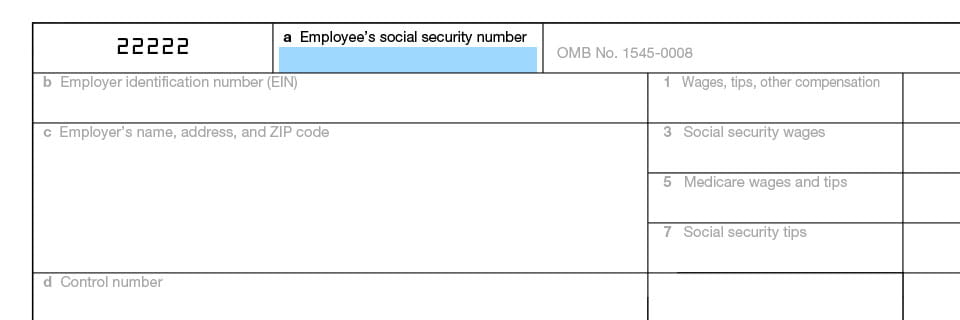
Nine-digit social security number of the employee for whom this W-2 form is being prepared for.
Field b: Employer Identification Number (EIN)
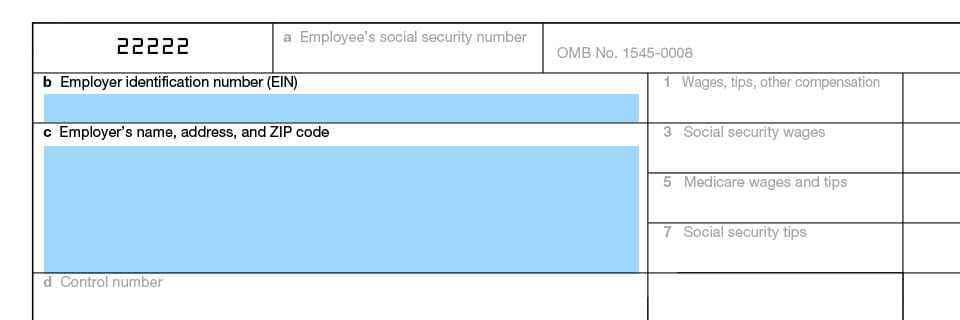
An Employer Identification Number (EIN) is the unique nine-digit number that the IRS assigns to businesses. Essentially, you must have an EIN in order to hire employees.
Field c: Employer’s Name, Address, and ZIP code.
You need to enter the full legal name you used when you registered your corporation or LLC, as well as the complete address of your business, including the ZIP code.
Field d: Control Number
The control number identifies each employee’s unique W-2 in the company’s records. Usually, the numbers are automatically generated by your company’s payroll processing software.
Fields e-f: Employee’s Name, Address and ZIP code.
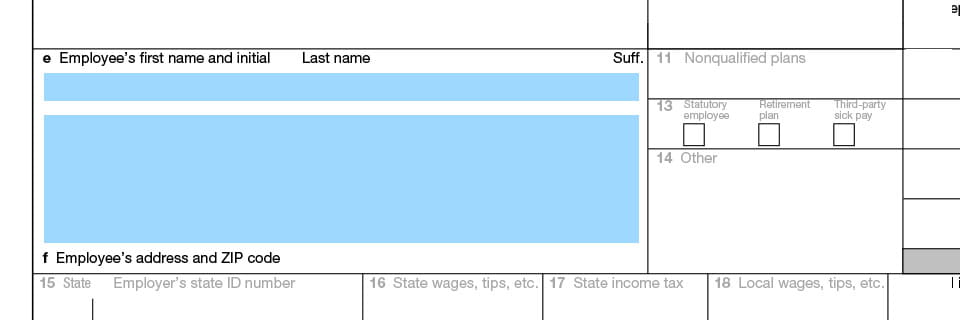
Make sure you have entered the current address of each employee. It’s a good idea to double-check to ensure this information is accurate.
Numerical Fields (1-20)
The numbered fields run in a double column on the right-hand side of the W-2 form and continue across the bottom of the form. Wages and federal tax information is contained in the right-hand columns.
Meanwhile, the bottom field displays state and local tax information in a series of horizontal numbered fields. It is divided by a dotted line to provide more than one space for entering information.
For example, if you have employees working for your business in more than one locality or state, you will need to fill out withholdings for each locality, utilizing the space on either side of the dotted line.
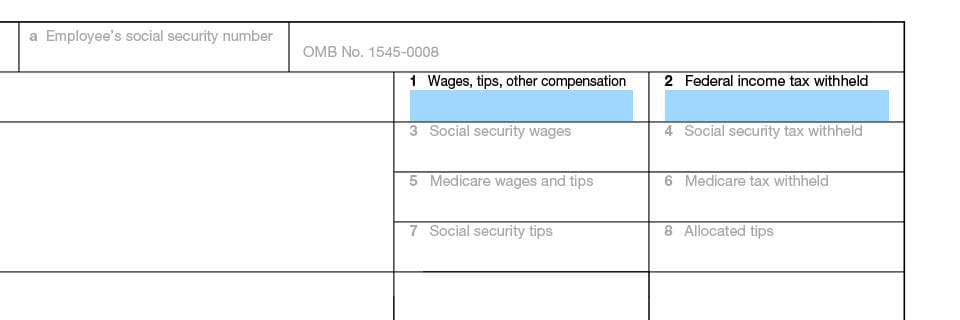
Field 1: Wages, Tips, Other Compensation
This field reports the total of all your employee’s taxable wages or salary, including bonuses and taxable fringe benefits like group term life insurance. However, it does not include pre-tax benefits, such as contributions to a 401(k) or health insurance plan.
Field 2: Federal Income Tax Withheld
How much federal income tax you withhold from a given employee’s paycheck depends on the number of withholding allowances they designated on their W-4 form.
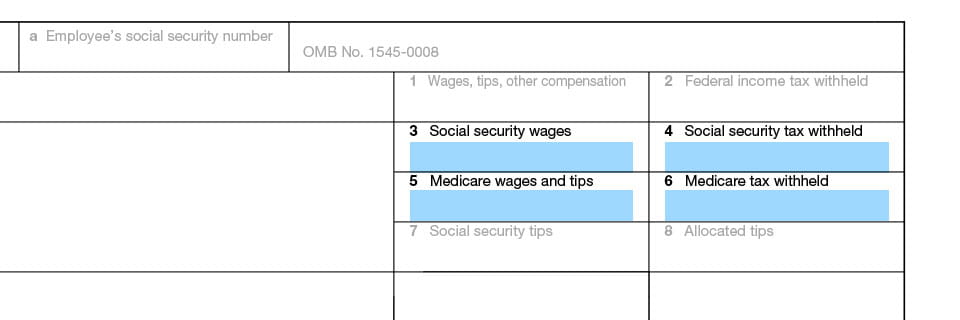
Field 3: Social Security Wages
Only a portion of each employee’s total wages is subject to tax from the Social Security Administration. Above a certain threshold— $168,600 in 2024—this so-called payroll tax stops. Therefore, no employee should have a wage larger than $168,600 entered in this field. Additionally, you don’t include employee tips in this field. For those, see Field 7.
Field 4: Social Security Withheld
Employers and employees contribute equally to this tax, paying 6.2% each of the employee’s wage up to the allowable threshold amount.
Importantly, the figure in Field 4 should not exceed the [taxable threshold] x [employer’s share], or $10,453.20 (6.2% of $168,600) in 2024.
Field 5: Medicare Wages and Tips
The figure you enter in this field reflects the total taxable income each employee earned with your company. Unlike Social Security, there is no maximum threshold.
Field 6: Medicare Tax Withheld
Employers and employees pay matching tax rates into Medicare — 1.45% each.
*Good to Know: Not only is there no upper threshold on Medicare earnings; highly compensated individuals must pay an additional .9% above the standard rate, or 2.35% for couples making over $250,000 a year. However, only the employee pays this additional tax, while the employer payment remains fixed at 1.45%.*
Field 7: Social Security Tips
You include employee’s reported tips in this field. When added to Field 3, the sum should equal the number in Field 1.
Field 8: Allocated Tips
If your business is a large food or beverage establishment, and the amount of tips an employee reported to you fell below the IRS’s approved percentage rate, you may need to assess additional compensation to your employees in the form of allocated tips.
However, unlike any tips reported in Field 7, this sum is not included in the amount of total income reported in Field 1.
Field 9: Advance EIC Payment
This field is a relic of a tax policy that no longer is relevant and should always remain blank.
Field 10: Dependent Care Benefits
You use this field to report income you reimbursed to an employee for dependent care expenses, including through a flexible spending account.
Field 11: Nonqualified Plans
This field is where you report any amounts you distributed to your employees from a non-government Section 457 pension plan or a non-qualified deferred compensation plan.
Additionally, this amount should be included as taxable income in Field 1 as well.
Field 12: Deferred Compensation
There are numerous forms of deferred compensation recognized by the IRS, each of which has its own tax code. The W-2 form mandates you to report as many of these forms of compensation as are relevant to your employees in Field 12.
For instance, some common types include group-term life insurance benefits in excess of the $50,000 worth you can provide as a tax-free benefit, and the non-taxable portion of temporary disability or sick pay. The IRS recognizes roughly 30 different forms of deferred compensation.
Field 13: Checkboxes for Statutory Employees, Retirement Plan, and Third Party Sick Pay
In this field, you check any of the three boxes that are relevant to the employee in question.
- For example, a “Statutory Employee” is someone who works for your company but doesn’t receive compensation in the form of a regular paycheck — for instance, they work exclusively on commission.
- You check “Retirement Plan” if your employees have access to a 401k or 403b at work, which may limit their ability to get tax incentives normally associated with an IRA.
- ”Third Party Sick Pay” refers to compensation your employee received from an outside party, such as an insurance company.
Field 14: Other
You can use this field to report any compensation that doesn’t fall into the other categories listed on the W-2 form.
Field 15: State ID Number
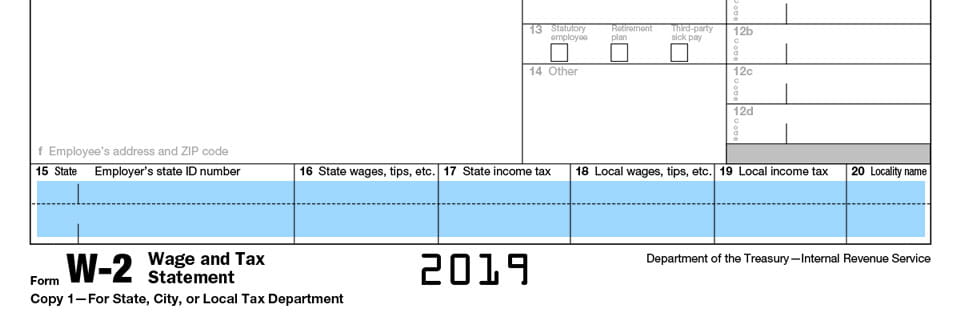
State ID numbers function in much the same way as EINs, serving to give your business a recognizable identity for tax purposes. The state ID number is only valid in that state.
*Good to Know: Whether you need a state ID for your business depends on several factors, such as how the business handles income and employment tax.*
Field 16: State Wages, Tips, Etc.
This field is where you report the income you paid to the employee that is taxable at the state level.
Good to Know: If they worked for your company in more than one state, you must separate the incomes out, placing the income taxable to each state on a separate line. If you do business in one of the seven U.S. states that has no income tax, this field will be blank. These are the aforementioned states:
- Alaska
- Florida
- Nevada
- South Dakota
- Tennessee
- Texas
- Wyoming
*In addition, Washington levies an income tax on investment income and capital gains, but it is only for certain high earners.*
**Elsewhere, New Hampshire currently taxes investment and interest income but is set to phase out those taxes starting in 2023. That will bring the number of states with no income tax to nine by 2027.**
Field 17: State Income Tax
This field shows the total amount of state income tax you withheld from your employee’s checks over the course of the year.
Field 18: Local Wages, Tips, Etc.
You report all income that is subject to taxation by your locality. This figure may be different than the figure in Field 16.
Field 19: Local Income Tax
If one or more of the localities you do business in requires employees to pay local income tax, this is the field where you report the amount.
Field 20: Locality Name
You’ll enter a brief description of the city or town that withheld taxes.
Where Do I Send the Completed Copies of my W-2 Form?

In total, there are six copies of the form that need to be distributed.
| Copy A | Sent to the Social Security Administration (SSA). Typically, it is submitted either electronically or on paper if fewer than 250 W-2s are being filed. |
| Copy B | This copy is for the employee to file with their federal tax return. |
| Copy C | This is for the employee’s personal records. |
| Copy D | This copy is for the employer’s records. Be sure to retain it for at least four years. |
| Copy 1 | This is for the city, state, or local tax department, and it is used to report state or local income taxes withheld. |
| Copy 2 | This copy is for the employee to file with their state, city, or local tax return, depending on the requirements of the locality. |
The FormPros Difference
Simplify your paperwork with FormPros! From creating paystubs, W-2s, and 1099-MISC forms to generating LLC Operating Agreements and even voided checks, our easy-to-use platform has you covered. Save time, reduce errors, and handle your business documents with confidence. Start now and see how FormPros makes professional form generation fast, affordable, and hassle-free!
Create Your W-2 Form with FormPros
We Can Help You!
- Create a W-2 Instantly
- Saves time and headaches
- Preview and share easily
- Easy to follow steps